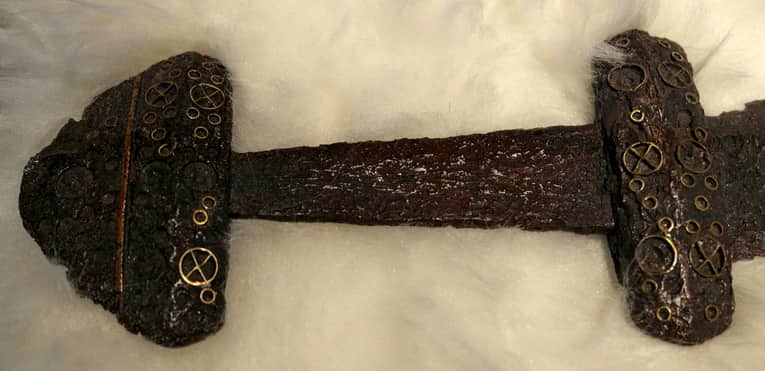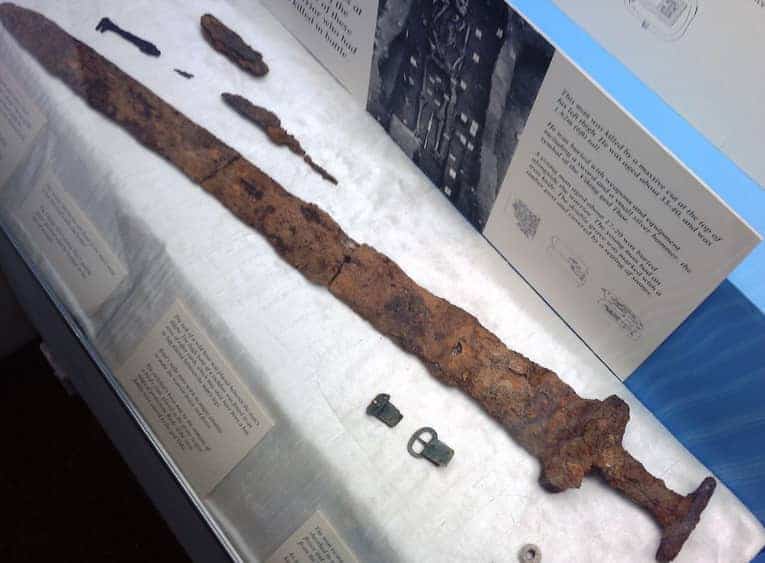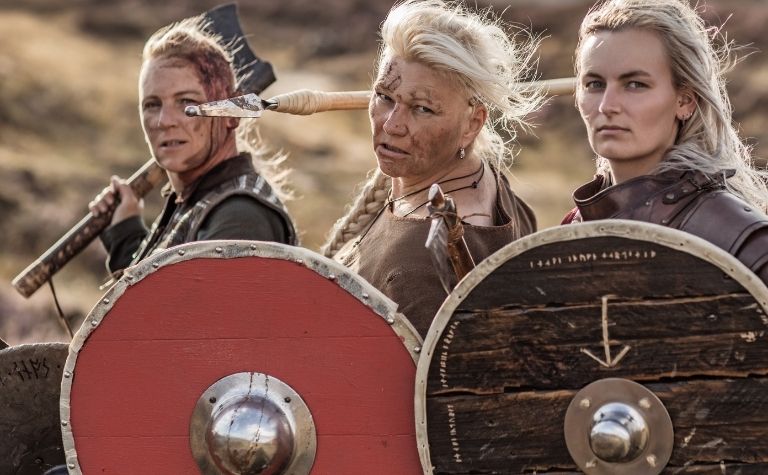There may not have been a more fearsome sight for coastal areas in Northern Europe during the Middle Ages than Viking longships silently approaching the shore, laden with the most ferocious warriors of their time.
The Vikings arguably achieved greater military accomplishments with less manpower than any society in history, and much of this can be attributed to their strong beliefs concerning the afterlife.
Vikings did not have to die with a sword in hand to reach Valhalla.
But only warriors killed in battle would be selected by Odin and his Valkyries to join them in the great halls of Valhalla, where they would spend the afterlife training by day and feasting by night until the arrival of Ragnarok.
Valhalla to the Vikings was more than just a destination in the afterlife, and unlike the Christian concept of heaven, it was not eternal bliss.
However, it was what all Viking warriors lived and fought for, and it was this deep aspiration to earn entry into Valhalla that fueled the unrivaled courage they displayed on the fields of battle.
Even though distinction beyond measure awaited them, so too did the apocalypse.
A lot of people are interested in the role of Viking women in their society. See Did Female Vikings Go to Valhalla? to learn more.

Valhalla was the Vikings’ Ultimate Goal
The mere act of dying while clutching a sword was not a guaranteed ticket into Valhalla.
If such were the case, then common farmers and even slaves could find themselves walking among great Viking kings and warriors in the afterlife.
The true measure by which Vikings were selected to enter Valhalla was not simply dying in battle but doing so with distinction and uncommon bravery (even by Viking standards).
Simply put, to reach Valhalla, Vikings had to die a true warrior’s death and not simply for ideological reasons or to uphold the Norse code of honor. (Also see Did the Vikings Ever Fight Samurai?)
There was a practical reason for limiting entry into Valhalla to those who had proven themselves in combat.
It had everything to do with Ragnarok, the Norse version of the apocalypse, the cataclysmic end of days. [1]
Interested in Norse Mythology? See 14 Great Books on Norse Mythology that explain the gods, heroes, and villains of these ancient stories of Scandinavia.

Only the Bravest Viking Warriors Entered Valhalla
The Viking people believed the gods of the Norse pantheon predetermined their fates.
In fact, not only did Odin and his Valkyries oversee the fallen warriors who reached Valhalla, according to many sources, but they actually selected who would live and die on the fields of battle, thereby steering those they deemed most worthy of joining their ranks in the afterlife. (Also see Valhalla vs Asgard: What’s the Difference?)
In the eyes of Viking warriors, Valhalla was the ultimate reward for fighting with distinction and dying with honor.
However, for the all-father Odin, leader of the Norse gods, the recruitment of Scandinavia’s finest fighters and most respected leaders to join his ranks of Einherjar in Valhalla was driven by the need to amass a fighting force worthy enough to face Fenrir and his evil cohorts. (Also see Do People Still Believe in Odin?)
According to Norse mythology, the ultimate battle between good and evil would result in a complete re-birth of the universe.
Sadly, even the events of Ragnarok had been foretold with Odin and most gods (including his son Thor), the mighty Einherjar, and virtually all living things the cosmos, fated to meet complete annihilation. [2]
The Vikings were known as fighters. See Why Did the Vikings Attack Monasteries? to learn more.

Valhalla was a True Warrior’s Paradise
Despite the knowledge that their time in the afterlife would come to an end and that they would fall once more in battle during Ragnarok, Viking warriors were resolute in their yearning to reach Valhalla. (Also see Do People Still Believe in Valhalla?)
Aside from the honor of being in the company of Odin and the Valkyries, the Einherjar experienced a true warrior’s paradise:
- They trained by day, fighting amongst each other, and any wounds they suffered would be healed
- At night, they feasted on the meat of a magical beast whose flesh would be restored by the next day to provide another day’s meal
- The mead they drank came from the udder of the goat Heidrun and was limitless in supply [3] (Also see Viking Recipes: How They Made Ale)
People love Viking history and many people want to own some of it. See Can you buy genuine Viking artifacts today? to learn more.
Most Vikings Warriors did not Even Own a Sword
Any edict from the Norse gods that only those Vikings who died with sword in hand could reach Valhalla would fly in the face of the warrior spirit instilled in these Norse people from birth failing to recognize the makeup of the men and warriors that comprised Viking fighting forces. (Also see What Did the Vikings Look Like?)
It would also disregard the harsh realities of life in general during the Middle Ages.
Because the metals used to produce swords (primarily iron in the case of the Vikings) were difficult to source and the process so laborious and specialized in crafting them, swords were extremely expensive to acquire, and only prominent and wealthy Vikings owned them.
Put another way, the overwhelming majority of Viking warriors could not afford a sword, let alone die on the field of battle with one in hand.
The most common weapons used by the Vikings in battle were those that were cheap to produce and affordable to all who needed them.
Spears
This was likely the most widely used weapon as only the tip needed to be forged from metal, while the staff (which varied in length from 3 to 10 feet long) was made from wood.
Spears were adaptable to fighting from a distance, in which case they would be hurled toward enemy soldiers, or in hand-to-hand combat where they would be thrust toward a target.
Axes
In a pinch, the same axe that was used to chop wood and perform menial tasks around the farm could be used as a weapon by lower-class Viking infantry.
Even specially crafted battle axes, which featured long handles and larger heads, were far less expensive to produce than swords but were capable of inflicting just as much damage (if not more).
Bows and Arrows
Born from hunting equipment, bows and arrows played a vital role in Viking military strategies as volleys of arrows could be launched toward enemy frontlines from great distances (over 600 feet), inflicting great damage to them.
Viking warriors would then advance to engage in hand-to-hand combat after these initial Medieval airstrikes.
Shields
Although primarily a defensive implement, shields could also be used as weapons in difficult situations.
Measuring three feet in diameter and constructed nearly entirely from wood, shields could be used to knock enemy soldiers off-balance, and they could even be used to strike at them along their edges.
Best of all, from the perspective of the common warrior, they could be built from readily available resources. [4]
Viking Warriors were Buried with their Weapons
Although scholars and the historical records have largely dispelled the notion that Vikings had to die with a sword in hand in order to enter Valhalla, archeological evidence has established that weapons and other personal effects belonging to the deceased played significant roles in:
- The ways that the Vikings buried their dead
- How the deceased were honored, and their community status recognized
- Preparing the dead for their time in the afterlife
The Viking practice of burying their dearly departed with personal items demonstrates their deeply held belief in the afterlife.
These so-called grave goods were considered to be absolutely essential to performing a proper burial as they would ensure that the deceased would carry on after death as they did during life.
For the wealthy, this meant luxury goods, and for warriors, this meant their weapons.
In the case of warriors killed in battle (and presumably chosen to enter Valhalla), they were buried with their full armament of weapons. (Also see The Viking Shield: The Meaning of Their Shape, Color, and Patterns)
They considered this logical, as they would surely need them to properly train with the other Einherjar in preparation for the arrival of Ragnarok and the waging of the greatest battle of them all.
Interestingly, many weapons found by archaeologists at gravesites have been determined to be deliberately broken as the Vikings believed that a warrior’s soul rested within the blade, and breaking it would release it to its final resting place.
This practice was also intended to discourage would-be grave robbers from disturbing burial sites. [5] [6]
Final Thoughts
Viking warriors aspired to die in battle so that they might reach Valhalla and fight alongside each other in the battle to end all battles.
References:
[1] historicmysteries.com
[2] pantheon.org
[3] norse-mythology.org
[4] historyhit.com
[5] lifeinnorway.net
[6] history.com
